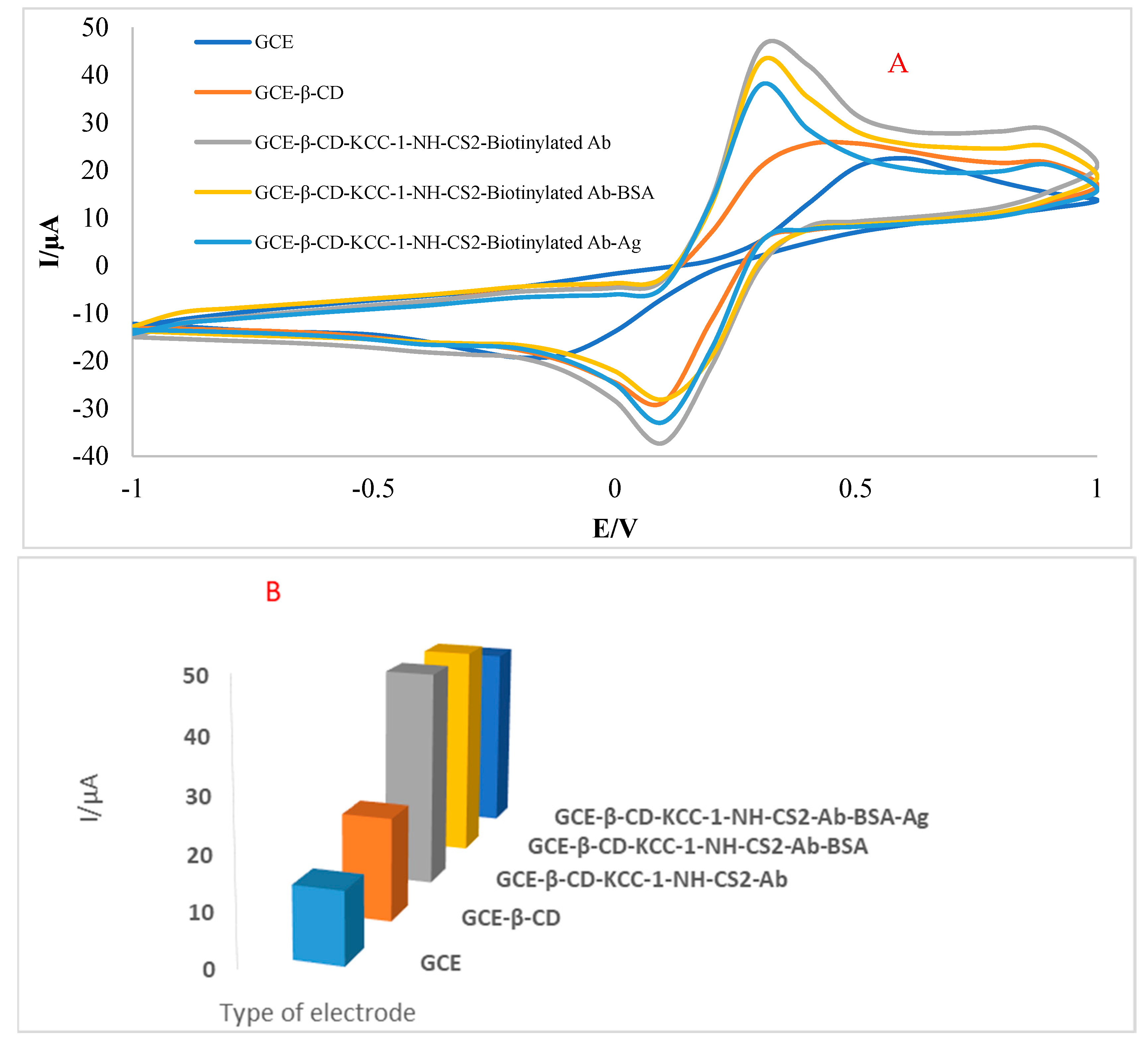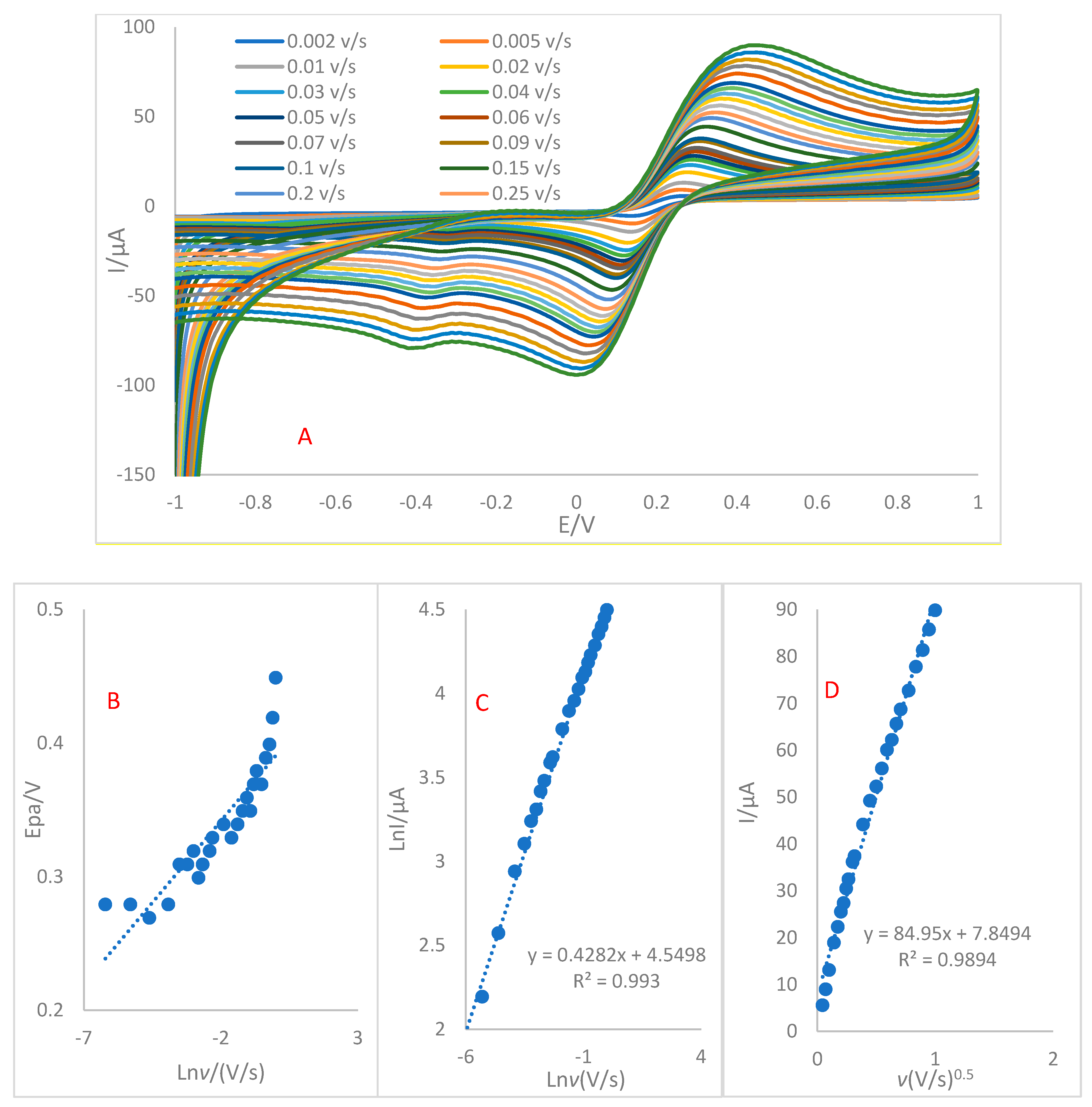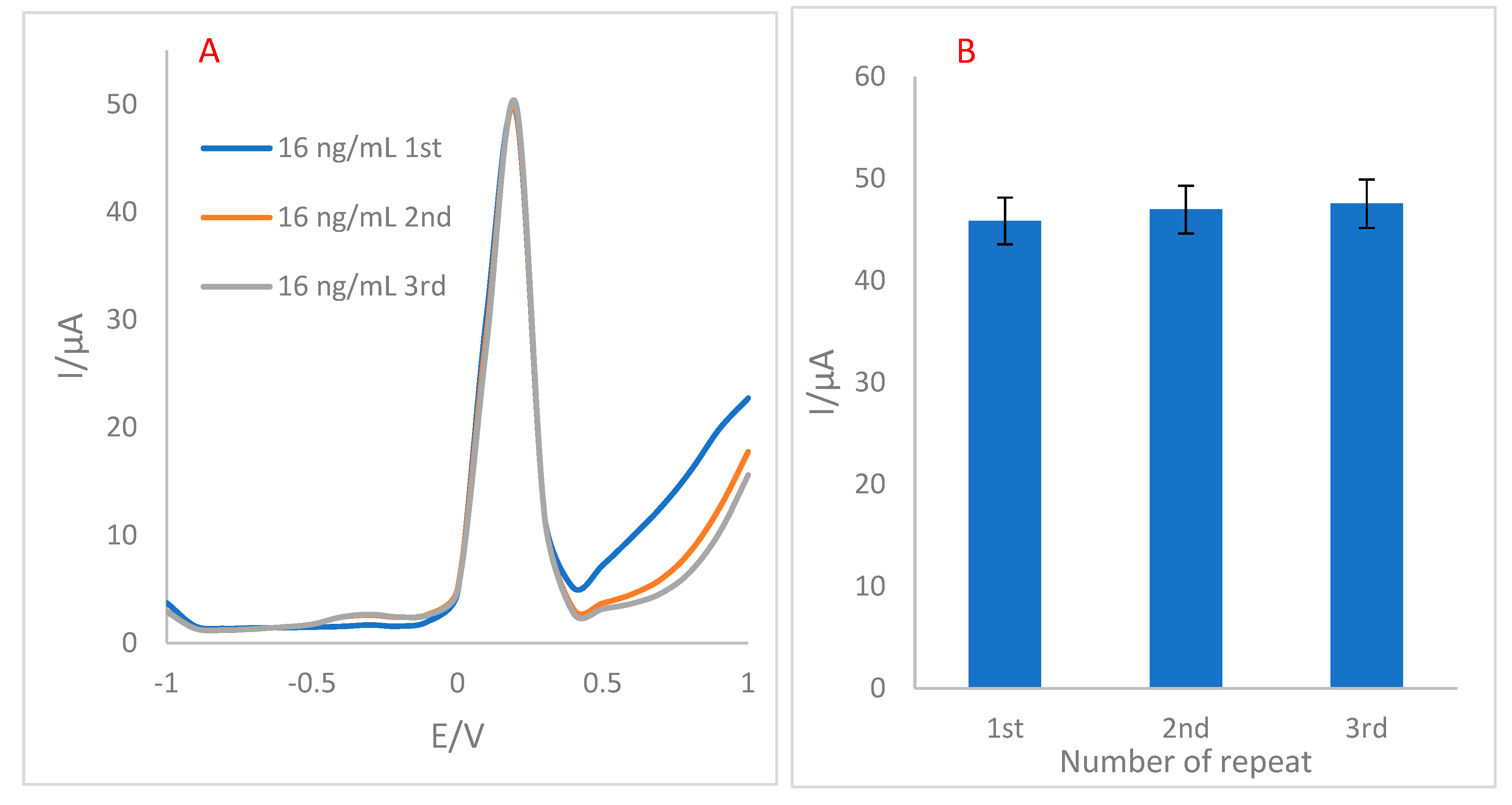Efficient Entrapment of Alpha-Synuclein Biotinylated Antibody in KCC-1-NH-CS2 and Application for the Sensitive Diagnosis of Parkinson’s Using Recognition of Biomarker: An Innovative Electrochemical Label-Free Immunosensor for the Biomedical Analysis of Neurodegenerative Diseases
Abstract
1. Introduction
2. Experimental
2.1. Chemicals and Reagents
2.2. Apparatus
2.3. KCC-1-NH-CS2 Synthesis
2.4. Encapsulation of the Antibody into KCC-1-NH-CS2
2.5. Preparation and Decontamination of the Electrodes
2.6. Electropolymerization of Beta-Cyclodextrin on the Surface of GCE
2.7. Immunosensor Assembly
3. Results and Discussion
3.1. The SEM Characterization of the Modified GCE
3.2. Electrochemical Properties of the Immunosensor’s Surface
3.3. Analytical Characteristics of the Immunosensor
3.4. Effect of Sweep Rate
4. Analytical Method Validation
4.1. Selectivity
4.2. Repeatability of Immunosensor
4.3. Inter-Day Repeatability
4.4. Stability Analysis
5. Conclusions
Supplementary Materials
Author Contributions
Funding
Institutional Review Board Statement
Informed Consent Statement
Data Availability Statement
Acknowledgments
Conflicts of Interest
References
- Siderowf, A.; Stern, M. Update on Parkinson disease. Ann. Intern. Med. 2003, 138, 651–658. [Google Scholar] [CrossRef] [PubMed]
- Dawson, T.M.; Dawson, V.L. Neuroprotective and neurorestorative strategies for Parkinson’s disease. Nat. Neurosci. 2002, 5, 1058–1061. [Google Scholar] [CrossRef] [PubMed]
- Litvan, I.; Halliday, G.; Hallett, M.; Goetz, C.G.; Rocca, W.; Duyckaerts, C.; Ben-Shlomo, Y.; Dickson, D.W.; Lang, A.E.; Chesselet, M.-F. The etiopathogenesis of Parkinson disease and suggestions for future research. Part I. J. Neuropathol. Exp. Neurol. 2007, 66, 251–257. [Google Scholar] [CrossRef] [PubMed]
- Shi, M.; Bradner, J.; Hancock, A.M.; Chung, K.A.; Quinn, J.F.; Peskind, E.R.; Galasko, D.; Jankovic, J.; Zabetian, C.P.; Kim, H.M. Cerebrospinal fluid biomarkers for Parkinson disease diagnosis and progression. Ann. Neurol. 2011, 69, 570–580. [Google Scholar] [CrossRef] [PubMed]
- Tao, D.; Gu, Y.; Song, S.; Nguyen, E.P.; Cheng, J.; Yuan, Q.; Pan, H.; Jaffrezic-Renault, N.; Guo, Z. Ultrasensitive detection of alpha-synuclein oligomer using a PolyD-glucosamine/gold nanoparticle/carbon-based nanomaterials modified electrochemical immunosensor in human plasma. Microchem. J. 2020, 158, 105195. [Google Scholar] [CrossRef]
- Mobed, A.; Hasanzadeh, M. Biosensing: The best alternative for conventional methods in detection of Alzheimer’s disease biomarkers. Int. J. Biol. Macromol. 2020, 161, 59–71. [Google Scholar] [CrossRef]
- Mobed, A.; Ahmadalipour, A.; Fakhari, A.; Kazem, S.S.; Saadi, G.K. Bioassay: A novel approach in antipsychotic pharmacology. Clin. Chim. Acta 2020, 509, 30–35. [Google Scholar] [CrossRef]
- Mobed, A.; Razavi, S.; Ahmadalipour, A.; Shakouri, S.K.; Koohkan, G. Biosensors in Parkinson’s disease. Clin. Chim. Acta 2021, 518, 51–58. [Google Scholar] [CrossRef]
- Mobed, A.; Hasanzadeh, M.; Shadjou, N.; Hassanpour, S.; Saadati, A.; Agazadeh, M. Immobilization of ssDNA on the surface of silver nanoparticles-graphene quantum dots modified by gold nanoparticles towards biosensing of microorganism. Microchem. J. 2020, 152, 104286. [Google Scholar] [CrossRef]
- Lequin, R.M. Enzyme immunoassay (EIA)/enzyme-linked immunosorbent assay (ELISA). Clin. Chem. 2005, 51, 2415–2418. [Google Scholar] [CrossRef]
- Hasanzadeh, M.; Shadjou, N. Electrochemical nanobiosensing in whole blood: Recent advances. TrAC Trends Anal. Chem. 2016, 80, 167–176. [Google Scholar] [CrossRef]
- Abdel-Aziz, A.M.; Hassan, H.H.; Badr, I.H. Glassy carbon electrode electromodification in the presence of organic monomers: Electropolymerization versus activation. Anal. Chem. 2020, 92, 7947–7954. [Google Scholar] [CrossRef] [PubMed]
- Da Silva, L.V.; Lopes, C.B.; da Silva, W.C.; de Paiva, Y.G.; dos Santos Silva, F.d.A.; Lima, P.R.; Kubota, L.T.; Goulart, M.O.F. Electropolymerization of ferulic acid on multi-walled carbon nanotubes modified glassy carbon electrode as a versatile platform for NADH, dopamine and epinephrine separate detection. Microchem. J. 2017, 133, 460–467. [Google Scholar] [CrossRef]
- Douhal, A. Ultrafast guest dynamics in cyclodextrin nanocavities. Chem. Rev. 2004, 104, 1955–1976. [Google Scholar] [CrossRef]
- Holzinger, M.; Singh, M.; Cosnier, S. Biotin—β-Cyclodextrin: A New Host–Guest System for the Immobilization of Biomolecules. Langmuir 2012, 28, 12569–12574. [Google Scholar] [CrossRef]
- Seidi, F.; Jin, Y.; Xiao, H. Polycyclodextrins: Synthesis, functionalization, and applications. Carbohydr. Polym. 2020, 242, 116277. [Google Scholar] [CrossRef]
- Seidi, F.; Shamsabadi, A.A.; Amini, M.; Shabanian, M.; Crespy, D. Functional materials generated by allying cyclodextrin-based supramolecular chemistry with living polymerization. Polym. Chem. 2019, 10, 3674–3711. [Google Scholar] [CrossRef]
- Abbasy, L.; Mohammadzadeh, A.; Hasanzadeh, M.; Ehsani, M.; Mokhtarzadeh, A. Biosensing of prostate specific antigen (PSA) in human plasma samples using biomacromolecule encapsulation into KCC-1-npr-NH2: A new platform for prostate cancer detection. Int. J. Biol. Macromol. 2020, 154, 584–595. [Google Scholar] [CrossRef]
- Maity, A.; Polshettiwar, V. Dendritic fibrous nanosilica for catalysis, energy harvesting, carbon dioxide mitigation, drug delivery, and sensing. ChemSusChem 2017, 10, 3866–3913. [Google Scholar] [CrossRef]
- Imisides, M.D.; John, R.; Riley, P.J.; Wallace, G.G. The use of electropolymerization to produce new sensing surfaces: A review emphasizing electrode position of heteroaromatic compounds. Electroanalysis 1991, 3, 879–889. [Google Scholar] [CrossRef]
- Ansari, R.; Hasanzadeh, M.; Ehsani, M.; Soleymani, J.; Jouyban, A. Sensitive identification of silibinin as anticancer drug in human plasma samples using poly (β-CD)-AgNPs: A new platform towards efficient clinical pharmacotherapy. Biomed. Pharmacother. 2021, 140, 111763. [Google Scholar] [CrossRef] [PubMed]
- Du, D.; Wang, M.; Cai, J.; Zhang, A. Sensitive acetylcholinesterase biosensor based on assembly of β-cyclodextrins onto multiwall carbon nanotubes for detection of organophosphates pesticide. Sens. Actuators B Chem. 2010, 146, 337–341. [Google Scholar] [CrossRef]
- Xie, S.; Zhang, J.; Yuan, Y.; Chai, Y.; Yuan, R. An electrochemical peptide cleavage-based biosensor for prostate specific antigen detection via host–guest interaction between ferrocene and β-cyclodextrin. Chem. Commun. 2015, 51, 3387–3390. [Google Scholar] [CrossRef]
- Kim, G.J.; Kim, K.O. Novel glucose-responsive of the transparent nanofiber hydrogel patches as a wearable biosensor via electrospinning. Sci. Rep. 2020, 10, 18858. [Google Scholar] [CrossRef] [PubMed]
- Behyar, M.B.; Kholafazad-kordasht, H.; Hassanpour, S.; Hasanzadeh, M. An innovative electrically conductive biopolymer based on poly (β-cyclodextrin) towards recognition of ascorbic acid in real sample: Utilization of biocompatible advanced materials in biomedical analysis. J. Mol. Recognit. 2022, 35, e2953. [Google Scholar] [CrossRef]
- Pereira, A.C.; Oliveira, A.E.F.; Bettio, G.B. β-Cyclodextrin electropolymerization: Mechanism, electrochemical behavior, and optimization. Chem. Pap. 2019, 73, 1795–1804. [Google Scholar] [CrossRef]
- Páramo García, U.; Ibáñez Cornejo, J.G.; Batina, N. Electrochemical modulation of the thickness of polypyrrole films by using different anionic dopants. Int. J. Electrochem. Sci. 2011, 6, 5172–5188. [Google Scholar]
- An, Y.; Tang, L.; Jiang, X.; Chen, H.; Yang, M.; Jin, L.; Zhang, S.; Wang, C.; Zhang, W. A photoelectrochemical immunosensor based on Au-doped TiO2 nanotube arrays for the detection of α-synuclein. Chem. Eur. J. 2010, 16, 14439–14446. [Google Scholar] [CrossRef]
- Sun, K.; Xia, N.; Zhao, L.; Liu, K.; Hou, W.; Liu, L. Aptasensors for the selective detection of alpha-synuclein oligomer by colorimetry, surface plasmon resonance and electrochemical impedance spectroscopy. Sens. Actuators B Chem. 2017, 245, 87–94. [Google Scholar] [CrossRef]
- Taghdisi, S.M.; Danesh, N.M.; Nameghi, M.A.; Ramezani, M.; Alibolandi, M.; Hassanzadeh-Khayat, M.; Emrani, A.S.; Abnous, K. A novel electrochemical aptasensor based on nontarget-induced high accumulation of methylene blue on the surface of electrode for sensing of α-synuclein oligomer. Biosens. Bioelectron. 2019, 123, 14–18. [Google Scholar] [CrossRef]
- Karaboğa, M.N.S.; Sezgintürk, M.K. Cerebrospinal fluid levels of alpha-synuclein measured using a poly-glutamic acid-modified gold nanoparticle-doped disposable neuro-biosensor system. Analyst 2019, 144, 611–621. [Google Scholar] [CrossRef] [PubMed]
- An, Y.; Jiang, X.; Bi, W.; Chen, H.; Jin, L.; Zhang, S.; Wang, C.; Zhang, W. Sensitive electrochemical immunosensor for α-synuclein based on dual signal amplification using PAMAM dendrimer-encapsulated Au and enhanced gold nanoparticle labels. Biosens. Bioelectron. 2012, 32, 224–230. [Google Scholar] [CrossRef] [PubMed]
- Ge, C.-Y.; Rahman, M.M.; Zhang, W.; Lopa, N.S.; Jin, L.; Yoon, S.; Jang, H.; Xu, G.-R.; Kim, W. An electrochemical immunosensor based on a self-assembled monolayer modified electrode for label-free detection of α-synuclein. Sensors 2020, 20, 617. [Google Scholar] [CrossRef] [PubMed]
- Aminabad, E.D.; Mobed, A.; Hasanzadeh, M.; Feizi, M.A.H.; Safaralizadeh, R.; Seidi, F. Sensitive immunosensing of α-synuclein protein in human plasma samples using gold nanoparticles conjugated with graphene: An innovative immuno-platform towards early stage identification of Parkinson’s disease using point of care (POC) analysis. RSC Adv. 2022, 12, 4346–4357. [Google Scholar] [CrossRef]
- Khatri, A.; Punjabi, N.; Ghosh, D.; Maji, S.K.; Mukherji, S. Detection and differentiation of α-Synuclein monomer and fibril by chitosan film coated nanogold array on optical sensor platform. Sens. Actuators B Chem. 2018, 255, 692–700. [Google Scholar] [CrossRef]
- Faulkner, L.R.; Bard, A.J. Electrochemical Methods: Fundamentals and Applications, 2nd ed.; John Wiley and Sons: Hoboken, NJ, USA, 2002. [Google Scholar]





| Index | Peak Position | Peak Height |
|---|---|---|
| GCE | 0.50028 | 13.4135 |
| GCE-β-CD | 0.40028 | 19.2955 |
| GCE-β-CD-KCC-1-NH-CS2-Ab | 0.30027 | 40.9655 |
| GCE-β-CD-KCC-1-NH-CS2-Ab-BSA | 0.30027 | 40.8493 |
| GCE-β-CD-KCC-1-NH-CS2-Ab-BSA-Ag | 0.30027 | 36.2842 |
| Used Technique | Bioreceptor | Interface of Electrode | LOD/LLOQ (ng/mL) | Linear Range (ng/mL) | Ref. |
|---|---|---|---|---|---|
| Photo-electrochemical | Antibody | Au–TiO2 NTs | 0.034 | 0.05–100 | [28] |
| EIS, SPR | Aptamer | Thiolated Au | 0.001 | 0.1 nM–0.5 µM | [29] |
| CV, DPV | Aptamer | Apt-CS-Au | 10 pM | 60 pM–150 nM | [30] |
| EIS, CV, SWV | Antibody | Au NP–PGA/ITO | 0.135 | 0.004–2 | [31] |
| EIS, CV | Antibody | PAMAM–Au/C | 0.0146 | 0.02–200 | [32] |
| DPV, EIS | Antibody | CYS/FTO | 3.62, 1.13 | 10–1000 | [33] |
| ChA, EIS | Antibody | AuNCs-graphene | 4 (LLOQ) | 4–128 | [34] |
| Optical (LSPR) | Chitosan film | AuNPs-chitosan | 70 nM | 70~700 nM | [35] |
| ChA | Antibody | P(β-CD) | 0.02 | 0.02–64 | This work |
Publisher’s Note: MDPI stays neutral with regard to jurisdictional claims in published maps and institutional affiliations. |
© 2022 by the authors. Licensee MDPI, Basel, Switzerland. This article is an open access article distributed under the terms and conditions of the Creative Commons Attribution (CC BY) license (https://creativecommons.org/licenses/by/4.0/).
Share and Cite
Navay Baghban, H.; Hasanzadeh, M.; Liu, Y.; Seidi, F. Efficient Entrapment of Alpha-Synuclein Biotinylated Antibody in KCC-1-NH-CS2 and Application for the Sensitive Diagnosis of Parkinson’s Using Recognition of Biomarker: An Innovative Electrochemical Label-Free Immunosensor for the Biomedical Analysis of Neurodegenerative Diseases. Biosensors 2022, 12, 911. https://doi.org/10.3390/bios12100911
Navay Baghban H, Hasanzadeh M, Liu Y, Seidi F. Efficient Entrapment of Alpha-Synuclein Biotinylated Antibody in KCC-1-NH-CS2 and Application for the Sensitive Diagnosis of Parkinson’s Using Recognition of Biomarker: An Innovative Electrochemical Label-Free Immunosensor for the Biomedical Analysis of Neurodegenerative Diseases. Biosensors. 2022; 12(10):911. https://doi.org/10.3390/bios12100911
Chicago/Turabian StyleNavay Baghban, Hossein, Mohammad Hasanzadeh, Yuqian Liu, and Farzad Seidi. 2022. "Efficient Entrapment of Alpha-Synuclein Biotinylated Antibody in KCC-1-NH-CS2 and Application for the Sensitive Diagnosis of Parkinson’s Using Recognition of Biomarker: An Innovative Electrochemical Label-Free Immunosensor for the Biomedical Analysis of Neurodegenerative Diseases" Biosensors 12, no. 10: 911. https://doi.org/10.3390/bios12100911
APA StyleNavay Baghban, H., Hasanzadeh, M., Liu, Y., & Seidi, F. (2022). Efficient Entrapment of Alpha-Synuclein Biotinylated Antibody in KCC-1-NH-CS2 and Application for the Sensitive Diagnosis of Parkinson’s Using Recognition of Biomarker: An Innovative Electrochemical Label-Free Immunosensor for the Biomedical Analysis of Neurodegenerative Diseases. Biosensors, 12(10), 911. https://doi.org/10.3390/bios12100911





